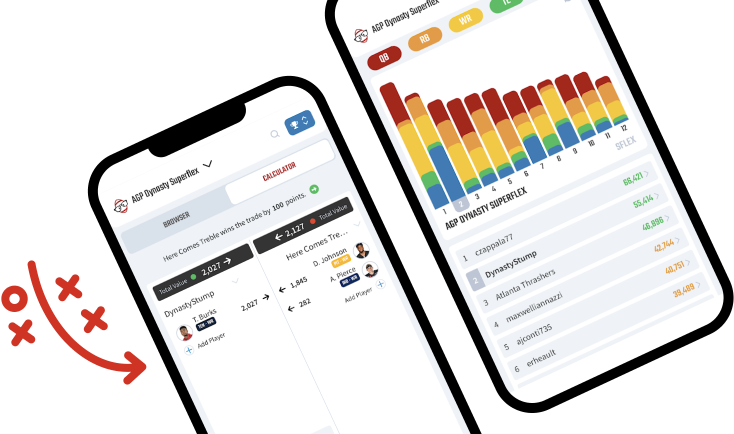Fantasy Z-Score Rookie Models & Charts
This chart is primarily dynasty-orientated for rookie drafts, and rookie projections are the most fickle of all projections considering the unknown. Please review the previous Fantasy Z-Scores articles with Dynasty Nerds on the overall process. For now, a quick and dirty explanation is I’ve combined every prospect metric, stat, and scaling factor I could find and blended them together with respect to their predictive power for fantasy points per game through a select period of a rookie’s early career. This ranges from yards per route run, production splits, team strength in terms of SRS and SOS, athleticism, market share, breakout age, film grades (which includes a factor, the excellent Dynasty Nerds Nerd Score), etc. As usual, each top-level category has multiple models feeding into it, and all the categories are weighted with their respective balance to finally get our expected PPG per player.
Let’s begin with running backs. You will be able to find wide receivers further down this article:
Running Back Fantasy Z-Score
Now that we have an overall feel for our running back rankings let’s take a deeper look at the profile of each player. This is indeed a weaker overall running back class, so keep this in mind in these ranks. Just because a player is RB2 or RB3 in this class doesn’t make them a first-round pick in rookie drafts, for example.
1. Jonathon Brooks

Somehow a non-consensus rank before the NFL draft, Brooks was and still is far and away the Z-Score RB1 of this class in a tier of his own. He has a letter grade above the field in industry film grades, very good production at Texas with the hardest team and schedule strength in the entire RB class, a quality receiver with 27 receiving yards per game, and strong YAC numbers. While he could not test at the combine or pro day due to his injury last season, his Athleticism Score still holds strong even if I plug in average testing numbers for his weight class since it also weights size, dual-threat ability, and broken tackle rate.
Just take a look at some of his closest analytic comps from the pre-draft perspective:

That is fantastic company from a fantasy perspective for the RB1 of a “bad” RB class. Landing in Carolina isn’t as bad of a situation as some might think from an overall team-scoring perspective. They added top-tier free agent guards this offseason to help bolster their line, brought in new coaching– our hero Dave Canales, who made Rachaad White of all players a workhorse, and limited competition in Hubbard and Sanders.
Take advantage of the uncertainty and use the injury fear as a fantastic opportunity to buy low at the back end of the 1st round of rookie drafts.
2. Marshawn Lloyd

Senior Bowl standout Lloyd is my next favorite in the class. Landing in Green Bay wasn’t ideal from a competition perspective, as Jacobs will handily lead the way, but all of his other metrics imply he is the RB2 of the class. The most eye-popping stat he showcases is an elite 37% broken tackle rate, one of the highest marks in my database around the likes of Josh Jacobs (how ironic), Javonte Williams, Devin Singletary, and Kareem Hunt, all of whom went on to have 1,000+ yard seasons and/or high touchdown usage. He also comes with respectable film and production grades, and at 220 pounds, he can definitely handle a multi-down role in the NFL. While not much else stands out as spectacular, he should be an effective while not elite back by most standards. All things considered, Lloyd is my favorite sleeper RB of the class and, once again, very affordable in rookie drafts.
3. Bucky Irving

Irving has a very unique profile. Of the running backs in my database who weigh sub-200 pounds, only three have a broken tackle rate above 30%: Tarik Cohen, Jerrion Ealy, and now Bucky Irving. His ceiling appears to be that of a very pigeon-holed pass-catching specialist in the NFL, and that’s worthwhile if he can hold down the role. Cohen had some good games and seasons in his role. Unfortunately, Irving landed with an already proven pass catcher in White, but fortunately, White should have never been a three-down RB to begin with and has horrific efficiency numbers. Note the bottom left of my Yards Created chart below:
2023 Yards Created Through Analytics
— David Zäch (@DavidZach16) January 30, 2024
– Achane had a stupid good year
– Lots of other young risers near top – Kyren, Warren, Gibbs, Hall, Bijan 📈
– Rachaad, Mixon, Sanders, Zeke multi-year bottom left corner finishes 😬
Note that +/- of ~0.25 falls within "as expected" range. pic.twitter.com/QfsWcGLu1G
Otherwise we have a rather disappointing profile from athletic testing and film grades. His production was still above average, and those irresistible receiving chops should make him a good floor, low-ceiling prospect. He should fly well under the radar and be a good plus-value target for the middle of round two-ish.
4. Trey Benson

If the phrase “peaks and valleys” were a running back prospect this year, it would be Trey Benson. Some of the high peaks: great speed score (4.39 40-time at 216 pounds), second-best industry film grade in class, and 17 receiving yards/game. Some of the low valleys: 70 rushing yards/game (14th in class), weak collegiate strength of schedule, and a low forced missed tackle rate. While he did very well at the combine, the rest of his “Athleticism Score” metrics were quite bad. This is just a confusing profile, and you could argue it either way. I tend to be a sucker for high speedscore players with receiving chops, but I’m going to lean into the landing spot more than the others with Benson. The Cardinals have a wide-open slot for RB2 that he should step right into and be the eventual successor to James Conner. This will make him a year two dependent buy for me, as I’ll likely be priced out for this year.
5. Ray Davis

There is not much worth noting here. Very near or slightly below average in all metrics, with a great landing spots to be the RB2 behind James Cook that the Bills have been searching for year after year after year. His profile is so uneventfully normal for an RB2/3 in today’s game that knowing he has a chance at carries in the Bills offense is all I need to know in this instance. It is worth a shot/prayer/wish/dart throw/etc. Pick your phrase and breathe in some hopium.
- Blake Corum

One of the more polarizing prospects of the class, many have had Corum as their RB1 coming into the draft. The Z-Score sees a very different picture, highlighted by one very damning stat:
Yearly reminder that there is a major red flag to avoid for Running Back prospects: extremely low broken/missed tackle rate.
— David Zäch (@DavidZach16) February 2, 2024
Here's your list for the 2023 class.
Buyer beware https://t.co/PH1MQPQTjL pic.twitter.com/KQMv1Z6zrb
His combine testing was also lackluster with below-average marks for his 205 weight. People laud him for his role at Michigan, but I see that as more of a crutch than an attraction. One of the best O-lines in college with a run-heavy coach feels risky at best to translate into the NFL. If anything, this is creating a lower perception of Kyren Williams now that he won’t be a full 100% snap player (this was very expected by whoever they added). Corum is likely a player I will end up with very little exposure to due to his surrounding hype perception and his projected Z-Score PPG differential.
The rest of the running back class can be found in the chart above. Some quick spark notes:
- While opportunity is available in the Chargers backfield, the Vidal hype is ludicrous. Round 6 picks with his profile hit once every 100 players. I don’t buy the hype.
- Jaylen Wright has a crazy high speed score, and being big and fast is worth a lot in McDaniels’ offense. But Achane had one of the most efficient RB seasons ever, and Mostert appears to be hanging on as long as he can in a major role.
- Tyrone Tracy will be worth a late flier. There is very little competition behind Singletary, and Tracy was hyped as a wide receiver converted RB, which are traits Daboll loves. Lots of respected analysts have been hyping him as a sleeper as well. I’ll nibble.
Wide Receiver Fantasy Z-Score

New this year is the inclusion of “Interview Scores” for the WR Fantasy Z-Score grades. These are characteristics observed through public interviews and how closely they align with previously successful WRs under similar interviews. It has done remarkably well for its first few years, enough so that I strongly believe it needs to be accounted for when projecting for fantasy, especially in terms of dynasty. Here’s a quick peek at how much stronger it has correlated to PPG when paired with draft capital, along with its history of performance if you follow through the threads:
I'm still reeling from how these scores have performed year after year after year.
— David Zäch (@DavidZach16) April 26, 2024
Btw, if you simply adjust a WRs draft capital with Interview Scores, you nearly DOUBLE the correlation to fantasy PPG.
Along with the hits vs draft props last night, we are on cloud 9 today😃 https://t.co/wfKFeg9p2e pic.twitter.com/12QkXgSZC9
Reminder of the adjustment factor of “Expected Team Passing Volume in Year 1”. This has no bearing on a player’s final exp ppg WR Z-Score; rather, it is an indicator of what to expect in the first year. The Z-Score for WRs projects more from a long-term dynasty perspective, and it is far harder to project passing volume from year two and onward, but that first year still affects their value. This can help us identify players who might hit their projected value earlier or later than expected. This accurately predicted a year-one spike for Jordan Addison from last year’s article if you look back, despite his overall profile being a shade lower than consensus. A “C” or lower for pass volume suggests buying after year one might be better. Players higher than that could become a sell-at-cost if their value becomes overly dependent on their pass-play volume.
1. Marvin Harrison Jr.

Harrison Jr. is one of those rare cases where it seems hell would need to freeze over for him not to be an instant WR1 tier for dynasty purposes. He is only the 7th player in the WR Z-Score to receive an “A+” grade. He has elite A+ marks from the industry’s leading film grades, outstanding efficiency (class leading 38% market share and top tier 3.6 yprr), and the only reason his draft capital wasn’t higher is due to quarterback need for real-life NFL teams. The only slight crease on a near-perfect resume is that he didn’t start his college career as fast as other elites, resulting in a “B+” career grade. If you need any more convincing that he is nearly bust-proof as they come, here are his closest Z-Score comps:

There is no signal between the naysayers saying he is a red-flag prospect because he skipped the combine and pro day workouts. For one, teams told him they didn’t need to see him perform there, and two, his interview score showcases a confident, humble, self-aware player who unsurprisingly carries himself very professionally. Paired up for the foreseeable future with Kyler Murray as his quarterback, you can tune out the noise and confidently take Harrison as your 1.01 in single-QB leagues.
2. Malik Nabers

“Ewwww, the Giants” was the first thought across the minds of dynasty slappies like myself when he went to them at 1.06. Who knows who his QB will be in two years, but let’s focus on the metrics that matter most here.
The LSU superstar led all wide receivers in final year YPRR and career Yards per Team Attempt -– two of the highest signal metrics we have available. If we knew nothing else about him, that might be enough. Adding gas to the fire is yet another “A” film grade, although slightly lower than Marvin Harrison Jr.’s, is still a remarkable feat.
However, when we adjust for team strength and strength of schedule, it bumps him down slightly. His market share and dominator rating are only a good bit above average, which is an indication of the sheer volume of production LSU had passing as a whole. His profile is just a different flavor than some other elite prospects, but his young age and home run ability make him a tantalizing option for fantasy.
3. Rome Odunze

Odunze has a remarkable profile that would very easily be the WR1 in many other draft classes. His trademarks are his big-bodied frame (6’-3″, 212 lbs, 32.25″ arms) and contested catch ability. He hits very good marks all around in all his analytic, film, and interview score grades as you can see above. He helped carry the Washington team through his college years as their focal point and is a very easy player to root for. His potential knocks are no “elite” marks in any category, just very good at everything, and his lack of top-end speed and quickness.
Overall, Odunze is an extremely safe draft selection that might be overshadowed in year one, being behind DJ Moore and Keenan Allen. However, a dynasty pairing with Caleb Williams is a nice stability to count on. He projects as a fringe WR1 for years to come.
4. Xavier Worthy

Famously nicknamed the Featherweight Ferrari (it’s not famous at all… but could it be?!??), Worthy is a 165-lb speedster (record fast 4.21 40-time) with dynamic route and movement ability. Worthy has a top-of-class breakout age, and at Texas, he never stopped producing gaudy numbers, giving him a class-best career-long grade of “A-.” His 99 interview score joins him with the likes of Garrett Wilson and Zay Flowers of previous classes; he clearly understands how to capitalize on his strength and expose defender weaknesses by hearing him explain his game. There are legitimate size concerns, but size for WRs has been losing signal to fantasy points for at least three years straight now, so the concerns are being dampened.
Pairing him with Mahomes is stupid perfect. I do not care about the uncertainty surrounding his competition in his rookie year (Rice legal issues, Marquise Brown’s return to form or not) because I believe in his profile and what I saw on film. Worthy is my favorite WR value of this year’s class, and I was deeply in even BEFORE the match made in heaven pairing with the Chiefs.
Worthy jumped over 30 spots in Underdog ADP and about 5 rookie spots in dynasty rookie mock drafts since these tweet 😅
— David Zäch (@DavidZach16) April 19, 2024
Being an unhinged obsessive sicko about fantasy has its edges. Only have to sacrifice your time, energy, and sanity and you too can stay ahead of the curve https://t.co/GXhYqaODXd
I’ll be actively trading up into the mid-late first round to target him.
5. Brian Thomas

Everyone’s favorite DK Metcalf 2.0 is my first slightly overrated WR in the Z-Score profile. The glaring concern here is his 7.7 Yards per Team Pass Attempt on a per-game basis for his career. This is normally representative of a 3rd-4th round NFL draft selection in the past. Now, part of this could be explained by playing next to Nabers, Daniels running the ball, etc., etc., but in the end, the best profiles rise above this – like Nabers did. His film grades, however, paint back end round 1 early round 2 NFL draft pick, but in my review of him, I had some heavy concerns about his change of direction, route running, and contested catch ability. His burst, size, and speed are undeniably very attractive, however.
Trevor Lawrence is undoubtedly a nice long-term pairing we can be happy with. However, the opportunity cost of a mid-first-round pick in most rookie drafts will likely leave me with fewer than-average shares.
6. Keon Coleman

Full disclaimer: I loved Coleman’s film. He was my first draft crush during the scouting process, and this is all BEFORE he landed on the Bills with Josh Allen.
Most predictive metrics out there tell us Keon Coleman will be over-drafted both NFL & fantasy wise.
— David Zäch (@DavidZach16) February 20, 2024
However, watching him is a context revelation. Looks every part of a NFL 1st RND pick & top-4 WR in class.
I am RARELY in on a player w/o strong analytics.
I am in on Keon. https://t.co/xPkVOvWqg3
The analytics hate him, the industry film grades say he's sub-par….
— David Zäch (@DavidZach16) April 23, 2024
But just feels like he has "it" watching him play as I studied through all his games.
Keon Coleman is my one pass I'm allowing myself this year with complete, irrational disregard of all other metrics. https://t.co/tUE4UqLLT4
His industry film grades are fairly average, and his analytic grades are even more bland, with mediocre marks in everything except the Dominator rating (read “TD Rainmaker”). However, watching every game of his final season told me he is a star in the making. For a large man with arguably the best catch attack in the class (he had at least two of the best catches in all of college football last year), he can move incredibly well, and his hip sink on curls and comebacks was particularly very effective. I have noted so many times where he beat his defender, but the quarterback seemed like he wasn’t even aware he was on the field. It was maddening at times. He can be sloppy on some routes and be more intentional with his movement, but the tools are there. They also utilized him as a return man, yet another testament to his YAC, ability to create in space, and make defenders miss. Red flags are everywhere in his profile, so the head says stay away, yet the heart wants what it wants, and I’m making an exception for him.
Everyone cites this catch, but I’m going to do it again because it truly is that good:
I can’t get enough of this Keon Coleman catch. 🍢🔥💯
— TJ Salomone (@TJSalomone) October 14, 2023
pic.twitter.com/KS1TAkDvzZ
7. Ladd McConkey

McConkey has a peculiar profile. On the one hand, his YPRR was pretty good in his final season at 3.3, but in the same stroke, his career YPTMA was one of the worst at 6.5. This tells us, even before getting to the film, that McConkey wasn’t on the field as much as his counterparts, but when he was, he was very often targeted and did well with his opportunities. He is a 4-year player with nice industry film grades but projects largely as a slot player in my eyes. His change of direction, sure hands, and knack for finding leverage against a defender highlight his upside. I am just not sure he sees enough volume, especially since landing with the Chargers, who are bringing back 90s-style run-heavy schemes. With consensus viewing him favorably, obtaining him at fair value might be hard/impossible.
8. Ricky Pearsall

Another player that stood out to me personally at cost includes Ricky Pearsall. The Florida standout doesn’t have any spectacular metrics (other than his elite 3-cone time of 6.64, which is one of the highest correlating combine metrics to fantasy success for WRs), but the mental makeup is there without a doubt with his rare 99 interview score as well. See for yourself in his interview with Thor Nystrom here:
Ricky Pearsall has had one of the best pre-draft processes of anyone — he’s my WR7 in the class
— Thor Nystrom (@thorku) March 28, 2024
At the Senior Bowl I spoke with him about the highlight-reel catches, the various high-profile QBs he’s been WR1 for, and who he patterns his game after
pic.twitter.com/l8xZIDLAW2
His sure hands, very good route running, and tenacity are my favorite traits about him, but the majority of the metrics speak otherwise. Landing with the Niners will force him into a likely quiet year one role behind Aiyuk, Deebo, CMC, and Kittle (provided none are traded), so be prepared to hold out for the long haul or buy low after a season here.
9. Troy Franklin

An analytic nerd’s wet dream (until he fell to the 4th round of the NFL draft), Franklin’s profile is littered with elite marks throughout. Franklin’s 3.7 YPRR in his final season was second only to Malik Nabers and well above MHJ and Odunze. Then it somehow gets even stronger when adjusting for team and opponent strength, making his comparables from adjusted YPRR a who’s who of undervalued assets:
I still can't get over Troy Franklin's efficiency his final season….
— David Zäch (@DavidZach16) April 19, 2024
Grouping final year YPRR when adjusting for team strength SRS. He's either massively underrated or he's D'wayne Eskridge… with 5:1 favorite odds on the massively underrated side pic.twitter.com/nZz9V2CAHA
While his industry tape scores came in at 84 (about a round 2 NFL grade), I saw a player whose suddenness was often unmatched by his opponents. On the other hand, his play suffered playing through contact, and he had some concentration drops tracking some deep balls.
Franklin will need a team that knows how to deploy his strengths well and capitalize with motion or off-line looks, and if that’s the case, he’s one of my favorite rookie selections this year.
10. Adonai Mitchell

If fantasy points from wide receivers were made athletic testing and the top 0.0001% of outcomes, Mitchell could be the 1.01. Luckily for us, we have found a wide range of metrics carrying heavy signals to fantasy success, of which Mitchell has red flags abound. Either worst or second-worst in most meaningful metrics of the entire WR class, Mitchell’s 2.2 YPRR or 6.07 career YPTMPA are near tombstone levels. Combine this with a very average 6.35 film grade from Lance Zierlein and a 76 interview score (worst since Jameson Williams and Kayshon Boutte), and you now have enough red flags that you could weave into a cozy little blanket for your household pet. He is completely off my radar.
The remaining prospects can be found in the overall wide receiver chart above.
Thanks for reading! This is a reminder that these are a general guide for rankings. I use as much information as I can that has historically been significant in predicting fantasy points for a player’s career. +/-1 ppg is a good way to classify tiers, and you should lean into your own conviction on players within a tier. If you liked reading this and like more tidbits throughout the season, you can find me on X at @davidzach16. Good luck, and happy drafting!








